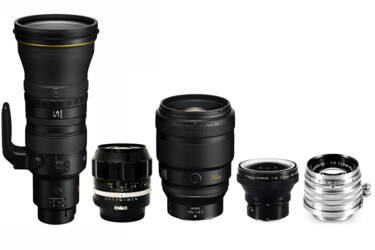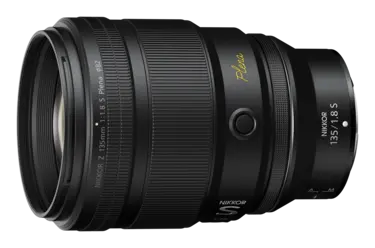Legendary NIKKOR lenses

From world firsts to becoming a movie star, NIKKOR lenses have seen it all
For the past 90 years, NIKKOR has been at the forefront of optical engineering, crafting some of the most famous lenses in photographic history along the way. Here we round up the very best.
NIKKOR Z 135mm f/1.8 S Plena (2023)
The latest legend from NIKKOR, the NIKKOR Z 135mm f/1.8 S Plena is an engineering marvel designed to take the fullest advantage yet of the Nikon Z mount’s width and light-gathering capabilities. Named after the Latin word ‘plenum’, meaning ‘full’ or ‘complete’, this is a true ‘bokeh monster’. This incredible portrait lens delivers amazing sharpness edge to edge (even when wide open) and near circular bokeh, beyond what has been achievable until now (for the story behind its engineering, read here).
Nikon Team

NIKKOR Z 135mm f/1.8 S Plena
NIKKOR N Auto 35mm f/1.4 (1971)
The world’s fastest SLR wide-angle prime at time of release in 1971, the NIKKOR N Auto 35mm f/1.4 became a regular fixture in the camera bags of many Nikon photographers who loved its versatility and low-light performance. This was also the first NIKKOR lens to feature multiple coatings, which were designed to minimise internal reflection and increase contrast in the final images.

NIKKOR N Auto 35mm f/1.4
Nikon AF Zoom Micro 70-180mm f/4.5-5.6D ED (1997)
A zoom lens with macro capabilities at every focal length from 70-180mm, this 1997-released lens was a real ‘two-in-one’ and a very advanced design for the time. With a maximum reproduction ratio of 1:1.32 at 180mm, it was capable of very high-quality close-ups while also retaining the convenience and advantages of a 70-180mm zoom.
NIKKOR P.C 8.5cm f/2 (1948)
Launched in 1948, this is the lens that began the popularisation of NIKKOR lenses outside Japan. Later, in the 1950s, it was extensively used by press photographers covering global stories, creating images of striking sharpness with beautiful bokeh.

Nikon AF Zoom Micro 70-180mm f/4.5-5.6D ED (left) and NIKKOR P.C 8.5cm f/2 (right)
Micro NIKKOR Auto 55mm f/3.5 (1963)
One of the most successful macro lens designs in NIKKOR’s history and the one that firmly established the Micro NIKKOR name, the Micro NIKKOR Auto 55mm f/3.5 was optically unchanged for nearly 20 years. Based on a lens designed for Nikon’s S series of rangefinder cameras, the F-mount version was a huge success, renowned for the clarity and quality of its images. Macro lenses like this were first developed for copying documents on to microfilm, and pin-sharp detail and clarity at high resolution were needed when imaging the fine brushstrokes of Japanese kanji characters.
AI NIKKOR 400mm f/3.5S ED-IF (1977)
This is the first NIKKOR lens to feature internal focusing (IF), a game-changing technology for sports and wildlife photographers using long telephoto lenses. Prior to IF, lenses focused by moving all the elements of the lens, meaning the whole lens changed length as you focused. Internal focusing meant the lens barrel stayed the same length while focusing, making handling of such lenses so much easier. The lens also included an ED (Extra-low Dispersion) element that reduced chromatic aberration.

Micro NIKKOR Auto 55mm f/3.5 (left) and AI NIKKOR 400mm f/3.5S ED-IF (right)
NIKKOR Z 58mm f/0.95 S Noct (2019)
Reserved for the wildest aperture lenses, the Noct name comes from the French nocturne, or ‘night scene’. The original Noct-NIKKOR was a 58mm f/1.2 lens produced between 1977 and 1997 and the name was used again for this flagship manual focus lens built to showcase the capabilities of the new Nikon Z mount. It is specifically designed to be used wide open for incredibly low-light results.

NIKKOR Z 58mm f/0.95 S Noct
PC NIKKOR 35mm f/3.5 (1962)
Another world’s first from NIKKOR, this was the first lens for 35mm film cameras to have interchangeable perspective control. The entire assembly could be moved by up to 11mm in 12 different positions, allowing the photographer to correct perspective distortion and converging verticals in the camera. This was especially helpful for architectural photographers in the film era who had to rely on tricky printing skills if they wanted to get rid of perspective distortion in an image.
OP Fisheye NIKKOR 10mm f/5.6 (1968)
In another world’s first for NIKKOR, this lens saw the introduction of the aspherical front element in an interchangeable lens. The large aspherical element was used to ensure that the light rays entering the lens converged on the same point, reducing spherical aberration and leading to much better image quality. Although the lens was originally designed for scientific use, its distorted fisheye view made it popular in creative and technical photography. These days, many NIKKOR lenses use aspherical elements in their design.

PC NIKKOR 35mm f/3.5 (left) and OP Fisheye NIKKOR 10mm f/5.6 (right)
NIKKOR 13mm f/5.6 (1976)
One of the most collectable and famed of NIKKOR’s historic lenses, the 13mm f/5.6 was a triumph of optical engineering and considered by some the greatest lens ever made by NIKKOR – or anyone else. Designing an ultra-wide lens that created images with no distortion was seen as almost impossible, but this lens proved the doubters wrong and offered a field of view previously only available via fisheye lenses. The complexity of the lens and challenges of manufacturing the large 115mm front element meant it was only available as a special order and as such only around 350 were ever made. Last year an original with box and filters sold for $50,000!
AF DC-NIKKOR 135mm f/2 (1991)
A lens that in its time was described as ‘the king of bokeh’ and ‘arguably the world’s greatest portrait lens’, the AF DC-NIKKOR 135mm f/2 raised the bar for professional portrait photographers across the world and, in many ways, is the direct ancestor of the NIKKOR Z 135mm f/1.8 S Plena. For this lens, NIKKOR introduced ‘Defocus Control’ on a separate dial – another world’s first. This allowed photographers to adjust the amount of spherical aberration for any given aperture, enabling the lens to create superb bokeh either in front or to the rear of the subject. Two years later, NIKKOR introduced a 105mm version that was smaller and lighter.

NIKKOR 13mm f/5.6 (left) and AF DC-NIKKOR 135mm f/2 (right)
NIKKOR Z 400mm f/2.8 TC VR S (2022)
Setting a new standard in telephoto lenses for wildlife and sports photographers, the NIKKOR Z 400mm f/2.8 TC VR S incorporates a 1.4x teleconverter that can be turned on and off instantly at the flick of a switch. It also has 5.5 stops of Vibration Reduction built in for rock-solid images. This was the first NIKKOR lens to feature the Meso Amorphous Coat, which gives the highest possible level of anti-reflection. At approximately 2.95kg, it is 20% lighter than the previous F mount version.

NIKKOR Z 400mm f/2.8 TC VR S
NIKKOR-H C 50mm f/2 (1937)
When Nikon started to manufacture consumer products, this was the ‘standard’ lens for rangefinder cameras, in both L and S mount versions. The 50mm delivered superb quality and sharpness due to its innovative optical design, featuring six elements in three groups, and became one of the most-used lenses of the era.

NIKKOR-H C 50mm f/2
Zoom-NIKKOR Auto 43-86mm f/3.5 (1963)
Yet another landmark for NIKKOR, this was the first standard zoom lens of a practical size, aimed at giving photographers an affordable and versatile zoom for everyday photography. Its small size and ease of use made it very popular and heralded the popularity of standard zoom lenses that continues to this day.

Zoom-NIKKOR Auto 42-86mm f/3.5
AF-S NIKKOR 14-24mm f/2.8G ED (2007)
One of the first lenses specifically designed for the digital era, this was the world’s fastest ultra-wide zoom lens when it was released along with the Nikon D3, the company’s first full frame DSLR. Its exceptional image quality set a new standard for ultra-wide zooms and is still available and used by professionals all over the world.

AF-S NIKKOR 14-24mm f/2.8G ED
AF-S NIKKOR 300mm f/4E PF ED VR (2015)
The introduction of the Phase Fresnel (PF) element to control chromatic aberration started with this NIKKOR telephoto, creating a lens that was lighter and smaller without compromising on quality. The use of PF elements means fewer elements are needed within the structure of the lens and therefore both size and weight can be reduced, giving photographers lenses that are much more comfortable and easier to handle on long shoots. A hit with wildlife and sports photographers, the lens is still available here.

AF-S NIKKOR 300mm f/4E PF ED VR
UW-NIKKOR 28mm f/3.5 (1965)
Photographing underwater is a challenge, not least because of the refraction of light that happens. The UW-NIKKOR 28mm was exclusively designed for underwater photographers by engineering a wide-angle lens that compensated for the refractive index of water, creating much sharper underwater images. It was made for the fully sealed Nikonos underwater cameras that were based on a design by the legendary diver Jacques Cousteau.

AF-S DX VR Zoom-NIKKOR 18-200mm f/3.5-5.6G IF-ED VR (2005)
Offering an enormous zoom range equivalent to 28-300mm for Nikon DX photographers, this was a do-it-all lens that delivered on flexibility without compromising on quality. Offering close focusing distances across the zoom range and in-lens Vibration Reduction, it offered fantastic sharpness for close-up images as well as the enormous reach of the zoom range, making it hugely popular.

AF-S DX VR Zoom-NIKKOR 18-200mm f/3.5-5.6G IF-ED VR
NIKKOR 8mm f/8 Fisheye (1962)
And finally, probably the only genuine movie star lens there has ever been. This was the first 35mm format fisheye lens from NIKKOR, but that’s not its claim to fame. The lens was used by Stanley Kubrick to provide the ‘all-seeing eye’ of HAL 9000, the rogue computer in his 1968 sci-fi classic 2001: A Space Odyssey and has become an icon of cinematic history. The original lens used in the movie was bought at auction by Lord of the Rings director Peter Jackson in 2010 for just over €20,000. View it here.
More in Gear
Featured products
Uncover NIKKOR lenses
What lenses are the pros using with the new Nikon Z 8?

Unlock greater creativity









